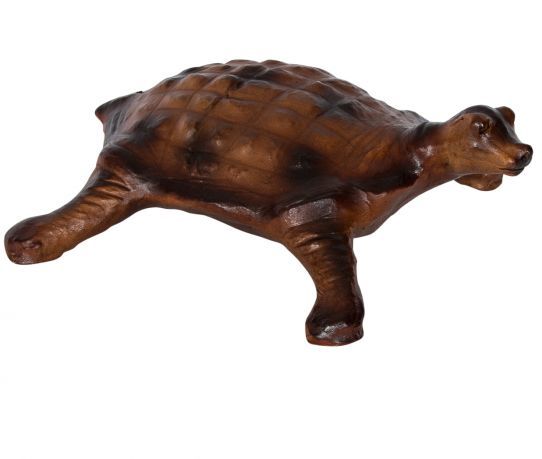We use cookies to make your experience better.
Turtle XL made from genuine leather
This art of creating life like animal statues from leather is now practiced inIndore, Madhya Pradesh. Craftsmen and their families practice this art and create miniature to life size versions of all types of animals, from horses, cows and elephants, to lions, tigers and rhinos of the jungle, to exotic creatures of the wild, like giraffes, zebras and meerkats. From a mere photographic reference, the craftsmen can make an accurate sculpture of the animal, complete with the details of posture and muscular curves and then paint them with lifelike colours depicting the skin patterns. Starting with the basic skeleton, craftsmen first make an armature with steel wires to act as the frame on which rest of the material will be supported. This is covered with tightly packed hay or waste paper, bound with strings to hold it together. This forms the body of the animal, which is then covered with cardboard pulp and given definition. On this soft outer cardboard covering, craftsmen and women shape the fine details of the animal’s anatomy, its muscular structure in different poses, to great accuracy. It is this expertise of the artisans to understand the structure of animal from a photograph and bring it out in three dimensions that makes this craft so remarkable. Once the cardboard dries, it can be coated with goat leather when required. Wet leather is beaten to increase its softness and flexibility. Using tamarind seed glue as adhesive, the craftsmen cover the animal structure with leather, taking care not to leave any unwanted wrinkles or folds. So neat is the leather coating, that it is difficult to find its edges. Once dry, the animal figure is dipped in dye and sun dried. The eyes and horns, which are made of glass or plastic, are then attached to it. And then, these artists add finishing touches of shading and painting the details of spots, stripes or patches on the animal’s skin, making it appear amazingly realistic. A final coat of leather polish completes the process.
Sea turtles (superfamily Chelonioidea), sometimes called marine turtles, are reptiles of the order Testudines. There are seven species of sea turtles. They are the leatherback sea turtle, green sea turtle, loggerhead sea turtle, Kemp's ridley sea turtle, hawksbill sea turtle, flatback sea turtle and olive ridley sea turtle. Four of the species have been identified as "endangered" or "critically endangered" with another two being classed as "vulnerable". The origin of Sea Turtles goes back to the Late Jurassic (150 Ma) with genera such as Plesiochelys, from Europe. In Africa, the first marine turtle is Angolachelys, from the Turonian of Angola. The difference between a sea turtle and other turtles is that their legs and arms cannot retract back into their shells.Sea turtles, along with other turtles and tortoises, are part of the order Testudines.The seven living species of sea turtles are: leatherback sea turtle, green sea turtle, loggerhead sea turtle, Kemp's ridley sea turtle, hawksbill sea turtle, flatback sea turtle and olive ridley sea turtle.[6] All species except the leatherback are in the family Cheloniidae. The leatherback belongs to the family Dermochelyidae and is its only extant member. The species are primarily distinguished by their anatomy: for instance, the prefrontal scales on the head, the number of and shape of scutes on the carapace, and the type of inframarginal scutes on the plastron. The leatherback is the only sea turtle that does not have a hard shell; instead, it bears a mosaic of bony plates beneath its leathery skin. It is the largest sea turtle, measuring 6 to 9 feet (1.8 to 2.7 m) in length at maturity, and 3 to 5 feet (0.91 to 1.52 m) in width, weighing up to 1,500 pounds (680 kg). Other species are smaller, being mostly 2 to 4 feet (0.61 to 1.22 m) and portionally narrower.Sea turtles constitute a single radiation that became distinct from all other turtles at least 110 million years ago Sea turtles are generally found in the waters over continental shelves. After taking to the water for the first time, males will not return to shore again. During the first three to five years of life, sea turtles spend most time in the pelagic zone floating in seaweed beds. Green sea turtles in particular are often found in Sargassum beds, a brown seaweed in which they find shelter and food. Once the sea turtle has reached adulthood it moves closer to the shore. Females will come ashore to lay their eggs on sandy beaches during the nesting season.The habitat of a sea turtle has a significant influence on its morphology. Sea turtles are able to grow so large because of the immense size of their habitat: the ocean. The reason that sea turtles are much bigger than land tortoises and freshwater turtles is directly correlated with the vastness of the ocean, and the fact that they travel such far distances.having more room to live enables more room for growth.
| Dimensions | 320 x 120mm |
|---|












